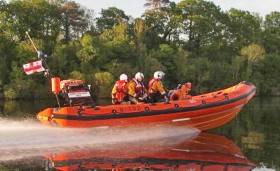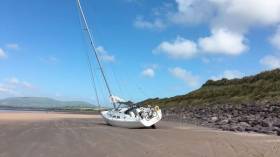Displaying items by tag: Storm Hector
Enniskillen Lifeboat Rescues Two After Boat Breaks Free From Jetty During Storm Hector
#RNLI - Enniskillen RNLI rescued two people on Lower Lough Erne after their 42ft cruiser broke free from its jetty during Storm Hector yesterday morning (Thursday 14 June).
Belfast Coastguard requested the launch of the inshore lifeboat at 6.42am, with the volunteer crew proceeding north to the stricken vessel close to the shoreline south of Rossigh.
With increasing winds through the night, the vessel had broken free from its mooring and some of the jetty was still secured to the boat.
The winds were starting to settle but they were estimated to be Force 6 or 7 when launching from the Lough Erne Yacht Club.
The lifeboat managed to refloat the vessel and brought it into safer water. The hire company then took charge of the cruiser with the lifeboat accompanying them to a sheltered location.
“With challenging conditions this morning the crews training was put into action and brought the two people and vessel to safety,” said Gary Jones, Enniskillen RNLI’s lifeboat operations manager.
Elsewhere, pagers sounded across the Irish Sea at Holyhead RNLI just after midnight on Thursday in the midst of the storm, with reports of an 18-metre yacht with mechanical failure west of the Skerries lighthouse off Anglesey.
At the scene, the lifeboat crew found the 60-tonne vessel, with two on board, had lost all power and was struggling to cope with the weather conditions, including southerly gale-force winds and spring tides.
The lifeboat undertook a tow of the stricken yacht, which was returning from the Isle of Man TT races back to her mooring at Holyhead. Both vessels arrived safely in port at 4.30am.
Speaking on behalf of Holyhead RNLI, press officer Vicki Owens said: “The weather was unseasonably rough, but our dedicated crew left their beds to help someone in trouble.”
The surprise Storm Hector was also responsible for blowing a yacht ashore on the Kerry coast, as previously noted on Afloat.ie.
Storm Hector Blows Yacht Ashore On Kerry Coast
#StormHector - One sorry yacht owner felt the wrath of Storm Hector today (Thursday 14 June) when their vessel was founded beached near Waterville in Co Kerry, as RTÉ News reports.
The Hanse yacht, named Seabiscuit, broke its mooring in Ballinskelligs Bay and was blown ashore on Inny Strand below Waterville Golf Course amid severe gusts that were forecast to reach as high as 125kmh overnight.
A Status Yellow small craft warning remains in effect on coasts from Hook Head to Erris Head to Howth Head with west to southwest winds reaching Force 6 or higher.





























































